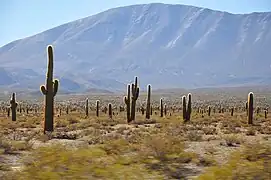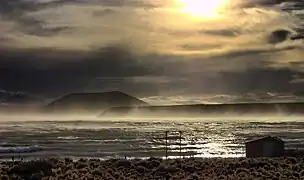 | |
| Continent | South America |
|---|---|
| Region | Southern Hemisphere |
| Coordinates | 34°00′S 64°00′W / 34.000°S 64.000°W |
| Area | Ranked 8th |
| • Total | 2,780,400 km2 (1,073,500 sq mi) |
| • Land | 98.43% |
| • Water | 1.56% |
| Coastline | 4,989 km (3,100 mi) |
| Borders | Chile 6,691 km (4,157 mi)[1] Paraguay 2,531 km (1,572 mi)[1] Brazil 1,263 km (784 mi)[1] Bolivia 942 km (585 mi)[1] Uruguay 541 km (336 mi)[1] |
| Highest point | Cerro Aconcagua, 6,960 m[1] |
| Lowest point | Laguna del Carbón, -105 m[1] |
| Longest river | Paraná River, 4,700 km |
| Largest lake | Lake Buenos Aires 1,850 km² |
| Exclusive economic zone | 1,159,063 km2 (447,517 sq mi) |
The geography of Argentina is heavily diverse, consisting of the Andes Mountains, pampas, and various rivers and lakes. Bordered by the Andes in the west and the South Atlantic Ocean to the east, its neighbouring countries are Chile to the west, Bolivia and Paraguay to the north, and Brazil and Uruguay to the northeast.
In terms of area, Argentina is the second largest country in South America after Brazil, and the eighth largest country in the world. Its total area is 2,780,400 km2 (1,073,500 sq mi). Argentina claims a section of Antarctica (Argentine Antarctica) that is subject to the Antarctic Treaty. Argentina also asserts claims to several British South Atlantic islands.
With a population of 46.6 million,[2] Argentina ranks as the world's 31st most populous country as of 2010.
Regions
Argentina's provinces are divided in seven zones regarding climate and terrain. From North to South, West to East:
- Argentine Northwest: Jujuy, Salta, Tucumán, Catamarca, La Rioja
- Gran Chaco: Formosa, Chaco, Santiago del Estero
- Mesopotamia: Misiones, Corrientes
- Cuyo: San Juan, Mendoza, San Luis
- The Pampas: Santa Fe, La Pampa, Buenos Aires, Córdoba, Entre Ríos
- Patagonia: Rio Negro, Neuquén, Chubut, Santa Cruz, Tierra del Fuego
Land use
- Arable land: 13.9%
- Permanent crops: 0.4%
- Permanent pastures: 39.6%
- Forest: 10.7%
- Other: 35.4% (2020)
- Irrigated land: 23,600 km2 (2020)
- Total renewable water resources: 814 km3/yr
Mountains and hills
Water resources
In Argentina, the fluvial net is integrated by many systems of different economic relevance, which could be measured by their amount of flow and navigability. Water flow relevance is based on its potential to be used for irrigation and as a source of energy. Depending on where the water streams drain, rivers and creeks could be classified into three different kinds of watersheds:
- Open or exorheic watersheds: they have exterior drainage (into the sea) - Parana River, Uruguay River, Negro River
- Closed or endorheic watersheds: they have interior drainage - Atuel River, Diamante River, Tunuyan River
- Areic watersheds: they lack of drainage and could be found in the center-west of the chaquenean plain, on the west of the pampean region and in some patagonic areas
On the other hand, lakes and lagoons are permanent accumulations of water over impervious depressions. Their difference is mainly based on their extension and depth. They are very important for stream regulation, as a source of energy, tourist attraction and its ichthyologic wealth. In Argentina, all major lakes are in Patagonia.[3]
Rivers
Major rivers in Argentina include the Pilcomayo, Paraguay, Bermejo, Colorado, Río Negro, Salado, Uruguay and the largest river, the Paraná. The latter two flow together before meeting the Atlantic Ocean, forming the estuary of the Río de la Plata. Regionally important rivers are the Atuel and Mendoza in the homonymous province, the Chubut in Patagonia, the Río Grande in Jujuy, and the San Francisco River in Salta.
Lakes
There are several large lakes in Argentina, many of them in Patagonia. Among these are lakes Argentino and Viedma in Santa Cruz, Nahuel Huapi in Río Negro and Fagnano in Tierra del Fuego, and Colhué Huapi and Musters in Chubut. Lake Buenos Aires and O'Higgins/San Martín Lake are shared with Chile. Mar Chiquita, Córdoba, is the largest saltwater lake in the country. There are numerous reservoirs created by dams. Argentina features various hot springs, such as those at Termas de Río Hondo with temperatures between 30 °C and 65 °C.
A recent global remote sensing analysis suggested that there were 3,091 km2 of tidal flats in Argentina, making it the ninth ranked country in terms of how much tidal flat occurs there.[4]
Climate
Argentina is subject to a variety of climates. The north of the country, including latitudes in and below the Tropic of Capricorn, is characterized by very hot, wet summers (which result in a number of swamp lands) with mild drier winters, and is subject to periodic droughts during the winter season.
Central Argentina has hot summers with tornadoes and thunderstorms (in western Argentina producing some of the world's largest hail), and cool winters. The southern regions have warm summers and cold winters with heavy snowfall, especially in mountainous zones. Higher elevations at all latitudes experience cooler conditions.
Political geography
Argentina borders five countries. Its largest and second largest international borders are the Argentina–Chile border, which is 5,308 km (3,298 mi) long, and the Argentina–Paraguay border which is 1,699 km (1,056 mi) long.[5][6][7]
International agreements:
- Party to: Antarctic-Environmental Protocol, Antarctic-Marine Living Resources, Antarctic Seals, Antarctic Treaty, Biodiversity, Climate Change, Climate Change-Kyoto Protocol, Desertification, Endangered Species, Environmental Modification, Hazardous Wastes, Law of the Sea, Marine Dumping, Nuclear Test Ban, Ozone Layer Protection, Ship Pollution, Wetlands, Whaling
 Argentina map of Köppen climate classification zones
Argentina map of Köppen climate classification zones - Signed, but not ratified: Marine Life Conservation
Strategic importance:
- Location relative to sea lanes between South Atlantic and South Pacific Oceans (Strait of Magellan, Beagle Channel, Drake Passage)
Territorial claims
- Land claims
- Maritime claims on Argentine Sea
- Territorial sea: 12 nmi (22.2 km; 13.8 mi)
- Contiguous zone: 24 nmi (44.4 km; 27.6 mi)
- Exclusive economic zone: 1,159,063 km2 (447,517 sq mi)
- Continental shelf: 200 nmi (370.4 km; 230.2 mi) or to the edge of the continental margin
- Elevation: 595 m (0.595 km; 0.370 mi)
National parks
The National Parks of Argentina make up a network of thirty national parks in Argentina. The parks cover a very varied set of terrains and biotopes, from Baritú National Park on the northern border with Bolivia to Tierra del Fuego National Park in the far south of the continent (see List of national parks of Argentina).
The creation of the National Parks dates back to the 1903 donation of 73 square kilometers of land in the Lake District in the Andes foothills by Francisco Moreno. This formed the nucleus of a larger protected area in Patagonia around San Carlos de Bariloche. In 1934, a law was passed creating the National Parks system, formalizing the protected area as the Nahuel Huapi National Park and creating the Iguazú National Park. The National Park Police Force was born, enforcing the new laws preventing tree-felling and hunting. Their early task was largely to establish national sovereignty over these disputed areas and to protect borders.
Five further national parks were declared in 1937 in Patagonia and the service planned new towns and facilities to promote tourism and education. Six more were declared by 1970.
In 1970 a new law established new categories of protection, so that there now were National Parks, National Monuments, Educational Reserves and Natural Reserves. Three national parks were declared in the 1970s. In 1980, another new law affirmed the status of national parks - this law is still in place. The 1980s saw the service reaching out to local communities and local government to help in the running and development of the national parks. Ten more national parks were created with local co-operation, sometimes at local instigation. In 2000, Mburucuyá and Copo National Parks were declared, and El Leoncito natural reserve was upgraded to a national park.
The headquarters of the National Park Service are in downtown Buenos Aires, on Santa Fe Avenue. A library and information center are open to the public. The administration also covers the national monuments, such as the Petrified Forest, and natural and educational reserves.
See also
References
- 1 2 3 4 5 6 7 "The world Factbook: Argentina". The World Factbook. Central Intelligence Agency. Retrieved December 13, 2013.
- ↑ "CIA World Factbook: Argentina". Retrieved 2012-06-26.
- ↑ Carlevari and Carlevari (2007).
{{cite book}}: Missing or empty|title=(help) - ↑ Murray, N.J.; Phinn, S.R.; DeWitt, M.; Ferrari, R.; Johnston, R.; Lyons, M.B.; Clinton, N.; Thau, D.; Fuller, R.A. (2019). "The global distribution and trajectory of tidal flats". Nature. 565 (7738): 222–225. doi:10.1038/s41586-018-0805-8. PMID 30568300. S2CID 56481043.
- ↑ "INDEC: Instituto Nacional de Estadística y Censos de la República Argentina". www.indec.gob.ar.
- ↑ "PARAGUAY GEOGRAFIA". August 17, 2018. Archived from the original on 2018-08-17.
- ↑ "Límites". September 2020.
Bibliography
 This article incorporates public domain material from The World Factbook. CIA.
This article incorporates public domain material from The World Factbook. CIA. This article incorporates public domain material from U.S. Bilateral Relations Fact Sheets. United States Department of State.
This article incorporates public domain material from U.S. Bilateral Relations Fact Sheets. United States Department of State.- UT Perry–Castañeda Map - Argentina Map Website Map
- Carlevari I. y R. Carlevari. 2007. La Argentina. Geografía económica y humana.14° edición. Alfaomega grupo editor. 543 pp.



.jpg.webp)



